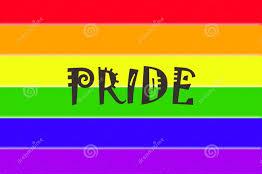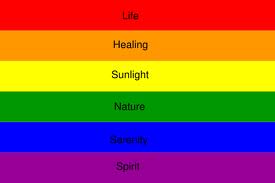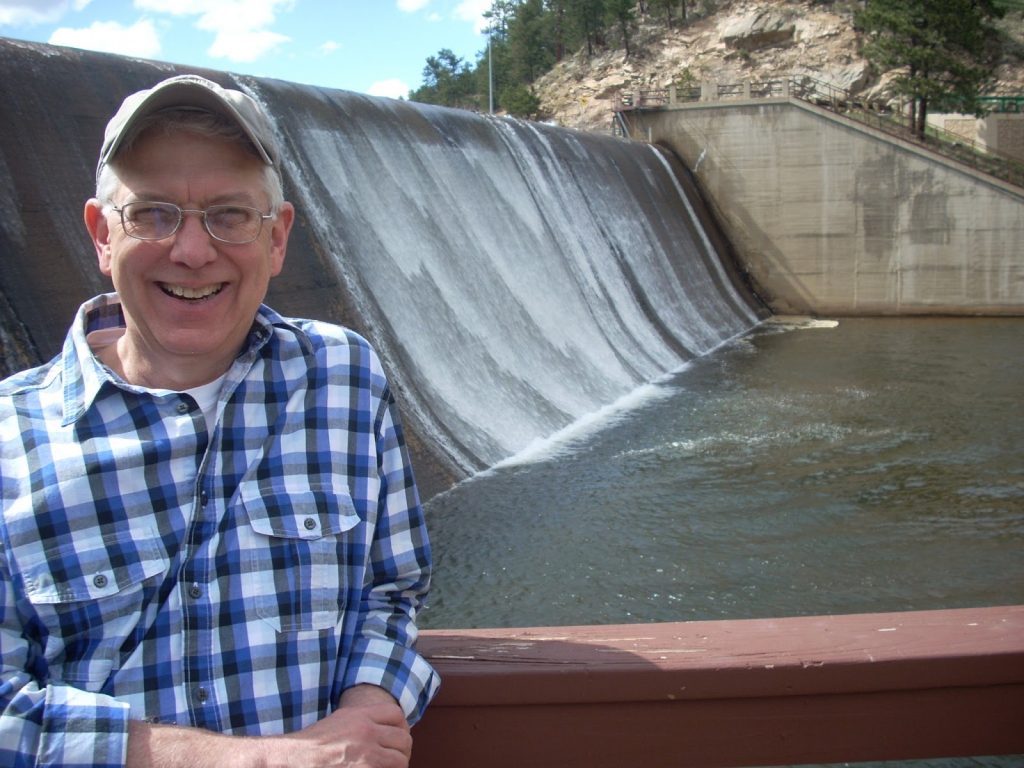My Gay PrideFest begins when Jim and I meet two friends at their Congress Park house. The four of us make our way through Capitol Hill, walking down Thirteenth Avenue with a side trip into Cheeseman Park where the parade is lining up. The air is cool, the sun warm, our feelings high. At the park, queer life pulses with enthusiasm as gay men, lesbians, cross-dressers, transsexuals, children of gay couples, elderly, young, Whites, Blacks, Hispanics, Asians, and more make ready to ride motorcycles, scooters and roller blades, to wave at the crowd from floats and convertibles, or simply to walk carrying logos, banners, and signs explaining their commitments.
At a park-side mansion we attend our first party of the day. Our tie-dye-tee-shirt-clad hosts welcome us and encourage us to meet other revelers. We eat sweet rolls, bagels, and more continental fare washing down our choices with coffee or Bloody Marys. I make conversation with folk I haven’t seen for months and, in one instance, years, conversations that feature great intensity and loads of laughter. When we say goodbye about an hour later, our hosts encourage us to return for brunch after the parade.
We hurry to Sixteenth Avenue to find the address where the second party we hope to attend is in progress. Our companion who most wants to attend this bash also most dreads it saying he’s afraid we might walk in on an orgy or a drug fest. I suggest that if it is either, he doesn’t have to have sex with anyone or take drugs, even if they are free. Laughing, we find the restored townhouse, enter, and greet our host who is genuinely happy we have stopped by. Our friend’s fears are unfounded. Still, a couple of people there are seriously drunk. One greets me a second time with open arms, not realizing he has already done so. It’s fine with me; I like his hugs.
We haven’t been there long when someone shouts, “The parade is underway.” Moving down the alley, I am pleased to discover we have missed the Dykes on Bikes, my relief not due to prejudice but, rather, because of the racket! We cross Colfax to get to the shady side of the Avenue just as PFLAG (Parents and Friends of Lesbians and Gays), this year’s honorary parade marshals, are coming down the street. As always, I appreciate their friendly smiles and good cheer. Chapters from around the Denver area wave signs that read, for example, “I’m the proud mom of a proud gay man” as they graciously receive the crowd’s enthusiastic affirmations of their important work on behalf of the community.
We join a fifth companion near Charlie’s of Denver, a long established gay club that serves as the parade’s official center with bleachers and an announcer introducing each group as it approaches. I turn my attention to the parade watchers, snapping photos of interesting hairdos, outfits, facial expressions, and of course, my companions. But I itch to join some other people I know at another location and eventually excuse myself. My friends agree to catch up with me later.
Taking pictures left and right I move west along the sidewalk dodging people coming east, dogs on leashes, and dense knots of parade onlookers. I click my digital record of a Black angel whose right wing looks like it may have broken when he fell to earth. I see a bear of a man on a motorized cart, my attention drawn by his garb, a profuse white tutu that strikingly contrasts with his worn out black leather shoes. He sits there topless except for a black leather dog collar and leash, black sunglasses, and a black and white Holstein bull motorcycle helmet sporting real cattle horns. I stop to take several shots of this man who is thoroughly enjoying the parade, shouting his delight as floats, cars, and marchers pass down the street. He cheers loudly for some dancers spinning by as if he remembers the days when he, too, could shake his booty at The Broadway, The Triangle, or Denver Wrangler.
When I look up from my snapping mania, I see my destination looming over the street ahead: the high towers, nave, and transepts of the Roman Catholic Cathedral of the Immaculate Conception. I take pictures as I approach the proud building with its high arches, elaborate spires, stained glass windows, triple entry, and prominent location near the Capitol building. Watching the parade from my vantage point just across the street clarifies for me values so important for gays and for all Americans. I watch the interaction of the crowd of onlookers along the street, gay marchers in the parade, protesters against gays, protesters against the Catholic Church, protesters calling gays to repentance, and the police who are alert to the possible need for crowd control in the dynamic environment. I greet the folks I hoped to meet there. They seem to be enjoying the parade. I snap their pictures and watch the drama.
I feel like I’m attending a medieval European Feast of Fools as the parade passes in front of the Gothic façade of the Cathedral. The juxtaposition of worshippers inside and revelers outside sets the scene. Folk inside searching for salvation, showing contrition, and carrying out pious acts seem such a contrast to folk outside enjoying the expression of liberation and impiously displaying pride. But the situation is much more complicated than that. I know that in the Cathedral gay worshippers gather alongside straight worshippers at every mass. I know that not all worshipers are pious or contrite and that not all gays are proud show-offs. I recall that religious leaders of Jesus’ time found him intolerable, given that in their opinions he was drinking too much and eating with the wrong sorts of people. I know that today the most intolerant and puritanical of church leaders often praise the ministries of gays in their choir lofts. The spirits of Church and Pridefest do contrast but not in a simple right and wrong sense. Both reveal great diversity; both reveal tolerance and intolerance. Well, of course, for both spirits are expressed by groups of people. We should expect friction when they rub shoulders on Gay Pride Sunday.
And here at the Cathedral corner come gays parading their diversity: a dozen or so royal families of drag queens and kings; the bars that have been oases for gays and lesbians for many years; the largely Gay churches such as the pentecostal Pillar of Fire and the almost mainline Metropolitan Community Church; several gay-affirming Unitarian, Lutheran, and United Church of Christ congregations; the domestic beer companies; a huge group of young people encouraging the parade watchers to get tested for HIV; the leather men; the dog owners; the bicycle riders; the club bunnies; the leathery skinned, sunburned old man in his thong and sandals; the politicos who affirm gay rights and seek the gay vote; a group of students from Denver Metro area’s Vantage Point alternative high school; the Stonewall Democrats whose presence reminds us that Gay Pride events across the country this year commemorate the fortieth anniversary of the Stonewall riot that gave such willpower to the gay liberation movement; the Transsexual community; the Gay Band; the Gay Choruses; the Gay square dancers; the Gay football league; the Gay swim team; the Gay Indians; and of course, Nuclea Waste, the drag queen on her high stilts, this year complementing her usual ensemble with a multi-color backpack of long balloons in neon colors exploding from her shoulders like a star burst. She is accompanied by several cute gay guys in tennis shoes and Speedos, each one also sporting a similar, but monochromatic, neon backpack—blue, green, yellow, orange, red, and purple—a cavorting rainbow of the brightest colors in the parade. But that colorful claim is challenged soon by a huge rainbow arch of balloons, a monstrously large rainbow flag, a Carnival of colors displayed by the Hispanic court of drag queens with their headdresses of dyed ostrich plumes, their supreme ruler surrounded by hundreds of peacock feathers, and finally, near the end of the parade, a hot pink feather boa measuring at least a quarter of a mile in length carried aloft by a couple hundred young people dressed in matching light blue shirts. The parade’s prismatic array surely stands as the ultimate symbol of Gay Pride and human diversity.
And me: I am here snapping shot after shot of diversity, enjoyment, exuberance, serious intent, history, love, and pride. And I do so proudly while myriad thoughts buzz through my consciousness.
Here, I think, power seeks to assert itself: secular power, religious power, democratic power, hierarchical power; powers moral and visionary. For years I heard the adage that politics and religion make strange bedfellows. Today I think the saying points to religious institutions vying for power within political structures. For example, maneuvering within the Republican Party resulted in a strange mix of secular and religious power brokers. Perhaps the coalition has now run its course, but one must understand as its background the establishment of religion in most of the Colonies and the history of assumptions of political power within the old Congregational churches—both Trinitarian and Unitarian. The eventual compromise necessary to unify colonies into a national government necessitated the separation of church and state but did not end the power of religious assumption. For Congregationalists, American democracy was an instrument of God, one that gave them community responsibility. Their mission was a pious and puritanical assertion of democratic power within their towns, states, and nation. We shouldn’t forget that the nineteenth century vision of Manifest Destiny had its origins in the preaching of biblical images. When religious conservatives in the late twentieth century began to assert political power with their values, religious liberals who had long done the same got worried, some even resentful. But what did they expect with the continuing success of several conservative denominations and the emergence of new evangelical independent churches? The neo-com religious powers’ interest to improve the country shouldn’t surprise anyone. Me? I’m liberal. I value the secular state, but I also realize the country has to guarantee both freedom of religious practice and freedom from religious tyranny.
The open sexuality of some dancers on a float going by reminds me of other strange bedfellows connected to American churches and to American political institutions. Sometimes such folk sleep over, and when the press reports it, American gays as well as American straights respond as if each affair is something original. We cluck-cluck and tsk-tsk shaking our heads at the impurity and hypocrisy while relishing and continuing the gossip. Like children taunting their siblings, American political leaders sometimes say “Shame on You” to American Presidents, Senators, Representatives, Judges, and Governors while the accusers are guilty of the same misdeeds. I hope that American attitudes will someday catch up with changes in American activities.
So here I am watching the parade—another dramatization of American life that for all its color is no more and no less sinful or righteous than any other public demonstration for civil rights based on truths self-evident. Its educational and celebrative purposes are noted, sometimes appreciated, and of course, derive their power by contrasting democratic principle with hierarchical assumption. Thus I love my corner view at Logan and Colfax where edificial security watches a free flow of traffic, of contrasting protests, of subcultural celebration, and of so much more that daily passes by its doorway.
The march goes on. One float invites onlookers to join them at the Civic Center PrideFest where they can get married! I don’t know what the legal outcome of their actions will be, but I do know what it symbolizes—the striving for civil rights. I applaud something I don’t seek for myself but do believe should be available in this American democracy even if the Roman Catholic Church, and many others, will never allow such ceremonies to be held within their hallowed walls.
I applaud. “Yes, America, march.” I want to shout, “March on, you Revelers for freedom.” I feel so Walt Whitman-ish but finally calm down when the parade ends. My four other companions join us here across the Avenue from the church. We enjoy more talk and good times. Then the five of us leave and return to the first party to have our fill of food and drink, and the good feelings of friendship, love, and pride—all in gay style. I tire of my picture taking and when I get home realize why. I have taken nearly 250 photos of my people, of my celebration, of my life.
Denver, 2009
About the Author
Phillip Hoyle lives in Denver and spends his time writing, painting, giving massages, and socializing. His massage practice funds his other activities that keep him busy with groups of writers and artists, and folk with pains. Following thirty-two years in church work, he now focuses on creating beauty and ministering to the clients in his practice. He volunteers at The Center leading “Telling Your Story.”
He also blogs at artandmorebyphilhoyle.blogspot.com


